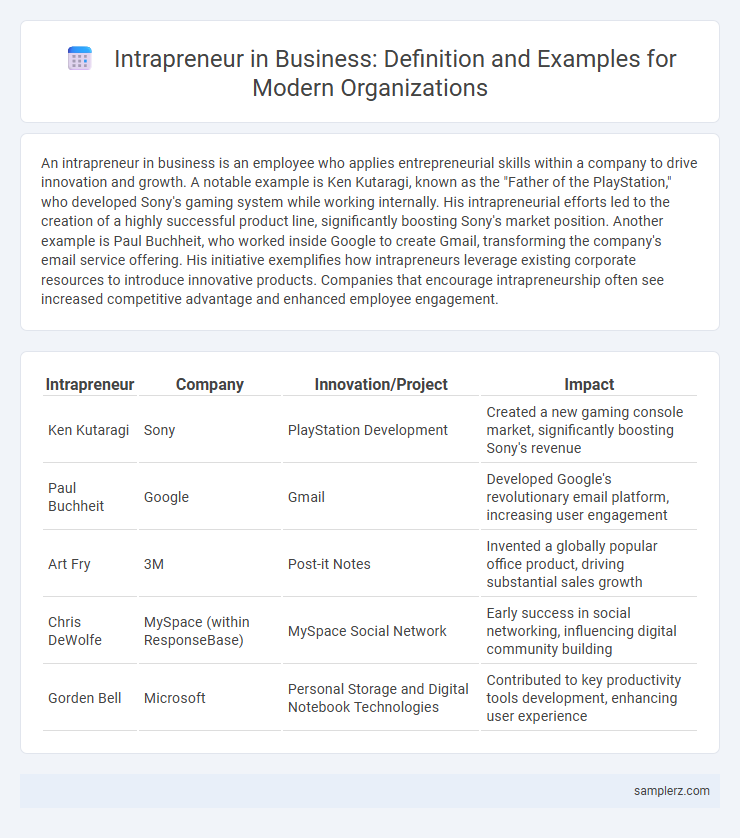An intrapreneur in business is an employee who applies entrepreneurial skills within a company to drive innovation and growth. A notable example is Ken Kutaragi, known as the "Father of the PlayStation," who developed Sony's gaming system while working internally. His intrapreneurial efforts led to the creation of a highly successful product line, significantly boosting Sony's market position. Another example is Paul Buchheit, who worked inside Google to create Gmail, transforming the company's email service offering. His initiative exemplifies how intrapreneurs leverage existing corporate resources to introduce innovative products. Companies that encourage intrapreneurship often see increased competitive advantage and enhanced employee engagement.
Table of Comparison
| Intrapreneur | Company | Innovation/Project | Impact |
|---|---|---|---|
| Ken Kutaragi | Sony | PlayStation Development | Created a new gaming console market, significantly boosting Sony's revenue |
| Paul Buchheit | Gmail | Developed Google's revolutionary email platform, increasing user engagement | |
| Art Fry | 3M | Post-it Notes | Invented a globally popular office product, driving substantial sales growth |
| Chris DeWolfe | MySpace (within ResponseBase) | MySpace Social Network | Early success in social networking, influencing digital community building |
| Gorden Bell | Microsoft | Personal Storage and Digital Notebook Technologies | Contributed to key productivity tools development, enhancing user experience |
Defining Intrapreneurship in the Modern Business Landscape
Intrapreneurship in the modern business landscape involves employees acting as entrepreneurs within a company, driving innovation and growth. Google's development of Gmail exemplifies intrapreneurship, where an employee's initiative led to a major product breakthrough. This approach fosters creativity and competitive advantage by empowering staff to develop new ideas without leaving the organization.
Key Traits of Successful Intrapreneurs
Successful intrapreneurs demonstrate strong innovation skills, risk-taking ability, and effective leadership within organizations. They possess resilience to navigate corporate challenges and a proactive mindset to identify opportunities that align with company goals. Key traits include creativity, strategic thinking, and excellent communication to drive new initiatives and foster collaboration.
Famous Examples of Intrapreneurs in Global Companies
3M's Art Fry invented the Post-it Note, revolutionizing office communication and exemplifying intrapreneurial innovation within a global corporation. Google's Sergey Brin and Larry Page fostered an intrapreneurial culture that led to groundbreaking products like Gmail and Google Maps. IBM's Bob O. Evans spearheaded the development of the SABRE airline reservation system, demonstrating intrapreneurial leadership in technology advancement.
How Intrapreneurs Drive Innovation Within Corporations
Intrapreneurs within corporations, such as Google's Sergey Brin and Larry Page, spearhead innovation by developing groundbreaking projects like Google Search and Gmail while leveraging company resources. They drive internal startup culture by identifying market gaps and experimenting with novel ideas without the risks associated with independent entrepreneurship. This approach accelerates product development and fosters competitive advantage, ensuring ongoing corporate growth and adaptability.
Case Study: Intrapreneurs Who Changed Their Companies
3M's Art Fry revolutionized the company by inventing the Post-it Note, transforming office communication and boosting 3M's product diversity. Google's Sergey Brin and Larry Page fostered an intrapreneurial culture leading to the development of Google Ads, which significantly increased revenue streams. Lockheed Martin's Skunk Works team pioneered advanced aerospace projects, including the U-2 and SR-71 Blackbird, showcasing intrapreneurship driving technological innovation within large corporations.
Intrapreneur vs Entrepreneur: Core Differences in Business
Intrapreneurs drive innovation within established companies by leveraging existing resources to develop new products or services, unlike entrepreneurs who start independent ventures from scratch. Intrapreneurs assume internal risks and operate under corporate structures, focusing on creating value that aligns with organizational goals. Entrepreneurs bear full external risks, control business decisions independently, and seek financial returns through market competition and startup growth.
Real-World Intrapreneurial Projects that Reshaped Industries
Google's 20% time policy empowered intrapreneurs to develop groundbreaking projects such as Gmail and Google News, revolutionizing email communication and news aggregation. Another notable example is 3M's intrapreneurship leading to the creation of Post-it Notes, transforming office supplies and organizational tools. These intrapreneurial initiatives demonstrate how fostering innovation within established companies can drive industry-wide disruption and sustained competitive advantage.
Cultivating Intrapreneurship: Tips for Business Leaders
Google's development of Gmail by employee Paul Buchheit exemplifies successful intrapreneurship, showcasing how empowering staff to pursue innovative projects drives business growth. Business leaders can cultivate intrapreneurship by creating a culture that encourages experimentation, allocating dedicated resources, and recognizing employees' creative contributions. Implementing structured innovation programs and providing ongoing support helps unlock employees' entrepreneurial potential within the company.
Measuring the Impact of Intrapreneurs on Business Growth
Successful intrapreneurs like Google's Sergey Brin and Larry Page have demonstrated measurable impacts by driving innovation that led to new revenue streams and market expansion. Quantitative metrics such as increased product development speed, higher employee engagement scores, and revenue growth from intrapreneurial projects provide concrete evidence of their influence. Companies that systematically track these key performance indicators (KPIs) experience significant competitive advantages and accelerated business growth.
Lessons Learned from Leading Intrapreneurs in Business
Successful intrapreneurs like 3M's Art Fry demonstrate the power of fostering innovation within corporate structures by transforming employee creativity into profitable products such as the Post-it Note. Lessons learned from leading intrapreneurs emphasize the importance of organizational support, including dedicated resources and a culture that tolerates failure, to enable risk-taking and experimentation. Business leaders gain insights on balancing autonomy with alignment to company goals, driving sustained innovation without sacrificing strategic focus.

example of intrapreneur in business Infographic
 samplerz.com
samplerz.com